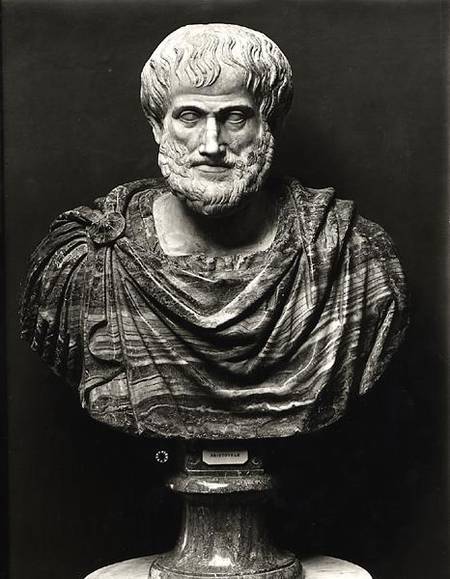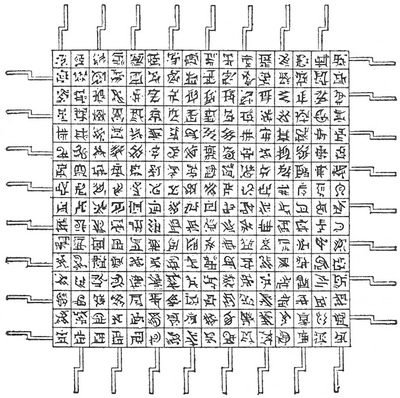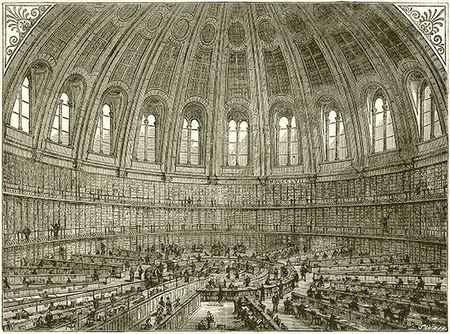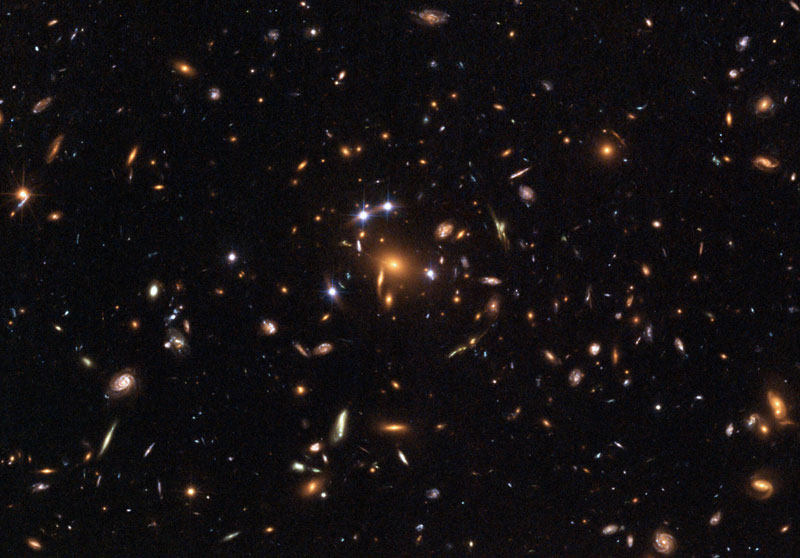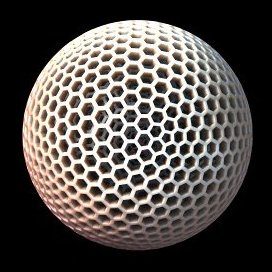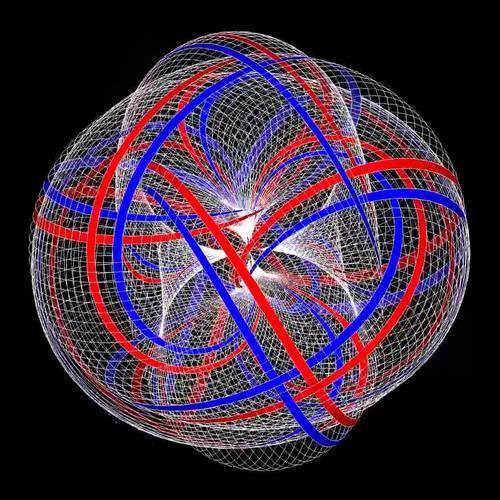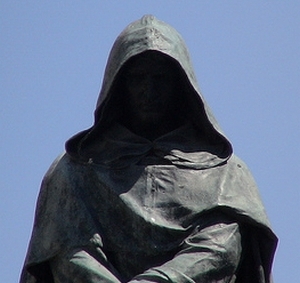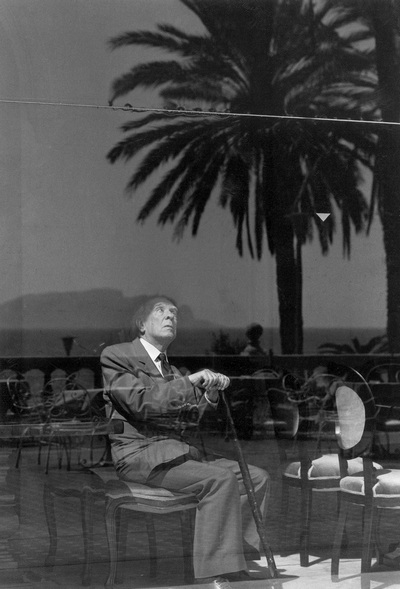Out among the labyrinthine digital bookstacks of the internet, there are many pages concerning ‘The Library of Babel’. Jorge Luis Borges’s famed short story has after all ensnared plenty of imaginations in its many (many) rooms since publication in 1944. These pages may be snappy wild-eyed entries on long-discarded blogs or fuller and ponderous articles bedded in obscure online journals – there is plenty of each – but they generally revolve around a relaying of the principles of the library as set down by Borges. Scrolling through the pages gives a sense of there being something meditative in simply sitting and copying the principles out, as if those few simple lines are the formula by which the whole cosmos blooms and in repeating them one might briefly grasp it.
In this way, the writers of these pieces are the wandering librarians, chanting the majesty of this idea which has got in them like a Gregorian ear-worm. I won’t pretend that I’m any less a zealot of this order, but I will here attempt to give what they generally forgo, which is firstly a look at where the library (henceforward capitalised, as only the truly cosmic deserves) is from in terms of a history of ideas; then a description on more mathematical terms of what the Library might look like; then a probably foolhardy attempt to unravel the nature of the awe and terror we feel when imagining the Library, and which keeps us wandering back through its boundless and amazing nonsense.
But first, as is customary, a prayer.
Sanctus, sanctus, sanctus
The Library is made of hexagonal rooms.
Each hexagon has six walls.
Each wall has five shelves.
Each shelf has thirty-two books.
Each book has four hundred and ten pages.
Each page has forty lines.
Each line has eighty characters.
Each character can be one of twenty-five symbols.
The Library contains all combinations of these symbols.
It therefore contains every thought you have had, will ever have, will never have.
And has contained them since the moment of its inception.
Amen.
Origins I: Fortune’s verse
Although a writer of short stories, poems, essays and generally pint-sized texts, Borges was not one to skim over ideas. His work can be seen as a slow orbiting of just a few notions and themes. One of these, less obvious, is the dissociation of thoughts from thinker. This is hardly a surprise coming from a librarian and bibliophile like Borges: books are the most enduring symbol and enactor of this idea, representing the moment at which a thought is transfigured from synapse to symbol. But the Library embraces this on a deeper level, where there are thoughts which have never been attached to any human mind.
How are such thoughts produced? A mechanism or process is needed, and perhaps the first recognisable cog of this was set in place by Leucippus and Democritus in the fifth century BC. They sought to explain the nature of change, and their suggestion was that the material world is made of tiny indivisible bits called atoms. A change in the world, they said, must really be a change in the configuration of atoms.
We know this via Aristotle, who calls their notion of change ‘alteration’ and compares it to another model, ‘coming-to-be’. The former can be used to explain change in a given thing through its constituent bits’ ‘grouping’ and ‘position’, while the latter might explain change through the bits’ ‘dissociation’ and ‘association’. The world, he philosophises, is all about bits and how they behave.1If this sounds obvious, that’s because Aristotle has already thought it for you. Among his musings on this lies the crucial zinger:
For tragedy and comedy are both composed of the same letters.
A mere neat little analogy this may have been for Aristotle, but in invoking stories, and particularly these two forms, his description of atomism hits on something enormous: the spectrum of human emotion.
It was three hundred years before the idea took further shape, when Cicero made an attack on atomism:
He who believes this may as well believe that if a great quantity of the one-and-twenty letters, composed either of gold or any other matter, were thrown upon the ground, they would fall into such order as legibly to form the Annals of Ennius. I doubt whether fortune could make a single verse of them.
Cicero intended this on mocking terms but he illuminates something more compelling than perhaps he realised. In this there is a method by which the atoms of an object might be transposed to the letters of a text, text which can describe any object. He also invokes a force which might be harnessed to produce non-human thoughts: fortune.2This is the fortune of the mythic mindset, a godly being which will choose the fate of humanity and may simply choose the same thing forever. Fortune in the more mathematical sense – probability – would not come until much later.
The ‘mechanism’ here described is the casting of letters, and this is significant not so much in its scattered physical bodies, like the rolling of a die or dropping of yarrow sticks, but more so as a symbolic system, delivering a message which is fairly direct, not reliant on the work of an interpreter or medium to assemble meaning out of it, and which somehow unfurls as a result of an initial set of parameters. A human might set these parameters but can’t anticipate all that they might produce. This dissociation from human intention was the crucial first step.
Origins II: Thinking machines
It wasn’t until the thirteenth century that a serious attempt was made to systematise this dissociation from human intention. ‘Serious’ is used advisedly as there is a certain absurdity to such an endeavour, and it was always to require a particular kind of eccentric.
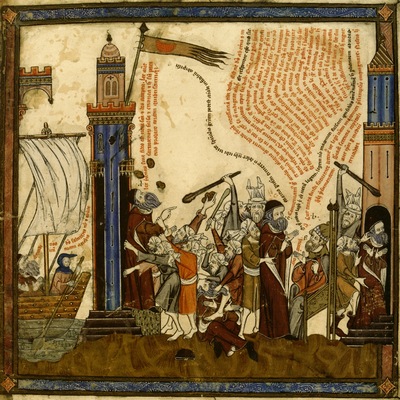
A theologian, poet, mystic, and prolifically inventive, the Spaniard Ramon Llull ticked all the right boxes. He was even prone to revelatory visions. One such vision, which was in a bush, caused him to see the letters of many alphabets become seared across its leaves. From this he wrote the Ars Magna, or Great Art, which details what came to be called simply his Art. Llull believed that all knowledge could be reduced to essential principles and categories, the manipulation of which will produce incontrovertible truths. The Art’s method is to present all combinations of these categories. Llull liked to symbolise these with letters.
This presenting of combinations can be performed through a diagram, but Llull also prescribed listing the categories around the edges of metal discs, one smaller and mounted in the centre of the larger. The categories, for Llull concerned with the qualities of God, can then be brought into new alignments through rotating the inner disk, in turn producing new, ‘truthful’ statements about the nature of God.
Martin Gardner, maths writer and magician, describes it like this:
The letter ‘A’, representing God, is placed in the centre of a circle. Around the circumference, inside sixteen compartments (or ‘camerae’ as Lull called them), we now place the sixteen letters from B through R (omitting J which had no existence in the Latin of the time). These letters stand for sixteen divine attributes – B for goodness (bonitas), C for greatness (magnitudo), D for eternity (eternitas), and so on. By drawing connecting lines… we obtain 240 two-term permutations of the letters… Thus we learn that His goodness is great (BC) and also eternal (BD), or to take reverse forms of the same pairs of letters, His greatness is good (CB) and likewise [it is] His eternity (DB).

Note that this is a not a Wheel of Fortune-style randomiser, it’s rather an aid to help the user work systematically through the combinations. It was viewed in various ways at the time (the Franciscans were fine with it, the Dominicans less so) though generally it was, and has since been, thought a mere novelty.
But Llull’s religious application of the Art can cloud a different sort of importance and value. Gardner describes it as ‘the earliest attempt in the history of formal logic to employ geometrical diagrams for the purpose of discovering nonmathematical truths, and the first attempt to use a mechanical device – a kind of primitive logic machine – to facilitate the operation of a logic system’. Anthony Bonner calls it a ‘distant precursor to computer science’.5It should be noted that the Art was developed as a means of using inarguable truth to convert non-Christians, in particular Muslims, and that this is amusing in light of Llull taking his algebra-style method (a sort of proto symbolic logic) from the Islamic world, as well as possibly the whole design of the Art. It very closely resembles the zairja, a device used by Arab astrologers to generate answers to questions through a process of what the fourteenth-century historian Ibn Khaldun calls ‘letter magic’. Llull travelled extensively in the Islamic world and even learned Arabic in order to aid in converting Muslims, so it is possible that he became aware of the techniques underlying his Art precisely from those whose worldviews he deemed so inferior and sought to change through its use. It wasn’t wholly effective because he was publicly stoned while preaching in North Africa, dying as a result. Though he did predict this years before, and in such a way the prophet can have the last laugh (especially when actively bringing about his own prophecy). This all of course makes things tricky when claiming that Llull is the source of the contributions ascribed to him. But it could be argued that the crucial step made between the zairja and the Art is that the latter was not for the purpose of divination. It was perhaps the first use of a generative process which was at its core non-supernatural.
None of this is to say that the Art in and of itself is right, of course. Borges recognises both its transferrable value and it reductiveness when he writes in his essay ‘Ramon Llull’s thinking machine’ that ‘We (who are basically no less naive than Llull) would load the machine differently, no doubt with the words Entropy, Time, Electrons, Potential Energy, Fourth Dimension, Relativity, Protons, Einstein. Or with Surplus Value, Proletariat, Capitalism, Class Struggle, Dialectical Materialism, Engels.’ This gets at both the transferability of its power and, perhaps for precisely this changeable, dressable nature, an ultimate futility in its failure to describe anything concretely.
This futility was earlier recognised by Jonathan Swift, when in Gulliver’s Travels the hero meets a professor who has invented a machine which orders words into a movable grid so that new combinations can arise as the machine is operated by a team of forty students. When something comprehensible emerges they write it down for it to be later organised into a book. The professor states to Gulliver that ‘Every one knew how laborious the usual method is of attaining to arts and sciences; whereas, by his contrivance, the most ignorant person, at a reasonable charge, and with a little bodily labour, might write books in philosophy, poetry, politics, laws, mathematics, and theology, without the least assistance from genius or study.’
The machine is said to have been inspired directly by Llull’s and it is of course a joke,6It may also be a dig at Leibniz’s claim in The Art of Discovery that a symbol-based system of logical rules could be made which would not just express the patterns of logical argument, as in formal logic, but which could also supply the reasoning that might dress those formal patterns in everyday discussion. In other words it would derive philosophical truths as well as logical ones; as Leibniz excitedly puts it, ‘when there are disputes among persons, we can simply say: Let us calculate’. This kind of intellectual hubris is of course payday for someone like Swift, but if we remove the element of deriving ‘objective truths’ then what’s left is Leibniz conceiving of the human mind on essentially computational terms, which he may have been the first to do and which has massive implications throughout science, notably in artificial intelligence. in the story producing only a few volumes of entirely broken sentences.
Origins III: Monkeys, molecules and the universe
The next step in the idea’s development came in the nineteenth century when experimental psychologist Gustav Fechner switched Llull’s use of words and concepts simply to letters, considering that all combinations of letters must encompass all possible notions. This is of course similar to Cicero’s statement two millennia before, and both men do agree that the spawning of a comprehensible notion is unlikely, but, armed with the field of probability (around since only the seventeenth century), Fechner was able to assert that within some kind of infinitely generating structure these notions must, eventually, emerge. With this the foundations of the Library were laid.
Fechner’s student and later biographer was Kurd Lasswitz, who was also one of the fathers of German science fiction. In 1901 he published ‘The Universal Library’, a short story in which a group of people, led by a Professor Wallhausen, speculate over just the structure needed to solidify Fechner’s idea. They discuss a universal library which contains all combinations of all letters in all books.7A simpler version of this had cropped up eight years previously in Lewis Carroll’s Sylvie and Bruno Concluded: ‘ ‘The day must come—if the world lasts long enough—’ said Arthur, ‘when every possible tune will have been composed— every possible pun perpetrated—… and worse than that, every possible book written! For the number of words is finite.’ ‘It’ll make very little difference to the authors,’ I suggested. ‘Instead of saying “what book shall I write?” an author will ask himself “which book shall I write?” A mere verbal distinction!’ ’ Fechner’s suggestion of the power of combined letters, plus Carroll’s extension of this into words and books, together can be seen as the grounding for Lasswitz’s library. Though it’s unclear whether Carroll was aware of Fechner, or Lasswitz of Carroll. Lasswitz was a scientist and does not shy away from the titanic numbers involved in realising his version of the Library,8Any version will differ foremost according to how the writer defines the number of words per page, pages per book, and dimensions of each book. For Lasswitz the books are two centimetres thick with 500 pages of in total a million characters. arriving at one which contains 102,000,000 volumes.
Quite apart from the physical scale of the books this invokes, the number itself is unimaginably large. Wallhausen claims it would take two miles of paper to write it fully, and yet ‘we can write down on a very small piece of paper the number of volumes comprising all possible literature’. The sheer mass of the gibberish which, in Cicero’s terms, fortune fails to turn into sensible texts, is now made into just that: mass. Wallhausen also states, mind-meltingly, that ‘To go from one end of the library to the other with the speed of light will take twice as many years as there are trillions of volumes in the library’.
In these ways Lasswitz introduces us to the Library as an object of scale and nonsense, and its structure finally begins to take shape.
In 1909 the mathematician Émile Borel took this idea of generating books out of sheer probability, the threads of this having been present and available for considerable time, as we’ve seen, and added monkeys. ‘Thousands of monkeys,’ he says, ‘randomly typing on typewriters, will reproduce exactly the contents of the Bibliothèque Nationale’. In 1928 the physicist Arthur Eddington gave the ‘infinite monkey theorem’ his own, perhaps more palatably anglicised, stab: ‘If an army of monkeys were strumming on typewriters they might write all the books in the British Museum’.
Eddington was not so much interested in the artistic potential of monkeys9Though don’t underestimate the importance of monkeys here, and not simply because it’s absurdist flourishes like this which so often carry ideas through history and into the minds of millions, but because of the artfulness in using primates as metaphor for what the generative process is: they are too naive to be God, the fortune of ancients times; they are too sentient to be pure abstraction, like probability. The monkeys are a powerful image because they are us, we who over a long enough timeframe are no less ignorant but who industriously tap out our works, so Borel’s monkeys retain that Darwinian echo of godlessness which we find disturbing and empowering in equal measure. As did those in the Plymouth University experiment to study the literary output of six actual monkeys, which consisted largely of the letter S before the keyboard was destroyed. Their musings were published as Notes towards the complete works of Shakespeare (British renditions of this thought experiment tend to obsess over Shakespeare). But this experiment disproves nothing, of course, because it did not last for infinite time. Borges rightly points out that over such an expanse only a single monkey should be required, strictly speaking (and probably a bigger research grant). as he was in claiming that certain events can be of such low probability that, while not impossible, they can reasonably be treated as such.10This may seem obvious, but to the sort of mind required of high achievers in maths and physics, wired as to treat the conceptually possible (like an imaginary number) as operationally indistinguishable from the hold-it-in-your-hands possible (like a pinecone or shoe), it is not. He made this point in the context of another image, that intellectual playpen so beloved of physicists at the time: the imaginary box full of imaginary wandering molecules. The box is symbolic of a ‘closed system’, a physical system which is not affected by its surroundings. A common example of this is the universe. The potential positions of its molecules represent the configurations of universe we might have.
Another pillar of this idea of molecules-as-letters can be seen by skipping back to the 1890s. This is essential to understanding Borges’s specific contribution to the development of these ideas (besides wrapping them up in a fantastic story), and that is the emotional resonances which extend from them. For this we go to Nietzsche.
The molecules in the universe are finite, he believed, so the number of their configurations is too. Within infinite time, the molecules must therefore assume every configuration11So long as we accept the second law of thermodynamics, wherein a closed system must tend towards greater chaos or complexity (that is, greater entropy) over time, and which I am willing to go out on a limb and accept. and so, eventually, repeat themselves, and the universe along with them. This is the basis of Nietzsche’s idea of the ‘eternal return’.
The idea of a cyclical, repeating universe long precedes Nietzsche, of course. It can be seen in the Buddhist and Hindu ‘wheel of time’ and in reincarnation. Krishna says in the Bhagavad Gita, ‘The same multitude of beings, which have lived on earth so often, are dissolved as the night of the universe approaches, to issue forth anew when morning breaks’. The ancient Egyptians, Mayans and Aztecs shared a similar view, while the atomists of ancient Greece touched upon it as described above. From them it became central to the work of Nietzsche. He extended its previous use as essentially an abstract thought experiment into the territory of the psychological and poetic, and especially enjoyed its capacity for doom: ‘The eternal hourglass of existence is turned over again and again’, he says in the The Gay Science, ‘and you with it, speck of dust!’
In Borges’s 1939 essay, ‘The Total Library’, in which he kindly reels off some of the Library’s forebears, he writes that the Library ‘is a typographical avatar of the Eternal Return’. This is to say that, overlaying letters with atoms, each ‘state’ of the universe is comparable to a book in the Library. So the Universe which is the sum of those states is comparable to the Library which is the sum of those books. The Library would then in a sense ‘repeat’ when one finishes its books and returns to the first, but this is less important for Borges. His main draw from Nietzsche is the sense of being trapped, haunted by the grand and life-affirming Truth that could always be in the next room, on the next shelf, but never will.
The Library’s substance is compiled. Now for its form.
Maths! I: Combinatronics
We’re all familiar with the realisation, probably when a kid and trying to access something purely because we’ve been told it’s off limits, that the possible combinations making up a short password or keycode can be bewilderingly massive. As with much delinquency this was highly educational as we were in fact dealing in combinatronics, the branch of maths concerning the combinations of objects which make up a larger object.
For a simple four-digit PIN, for instance for your mother’s credit card, one must consider the possible symbols which might sit in the four positions. With 10 possible digits, 0–9, the number of possibilities for the first and every position is 10. Each ‘filled’ position provides ten new possibilities for expanding on the previous ‘filled’ positions in all potential combinations, so the number of digits is multiplied by itself once for every position. That’s 10 X 10 X 10 X 10, or 104, which is 10,000.
In this context the value of each digit is irrelevant; they’re just symbols used to mark the ways of filling the positions. That means that it’s the same process for determining words, so this is all we need for determining the number of books in the Library.
As noted in our opening prayer, Borges offers the elements needed to work this out. It will first be 410 (number of pages in a book) X 40 (lines to a page) X 80 (positions to a line) to give us 1,312,000, which is the number of fillable positions per book. Using 25 orthographic symbols (an alphabet of 22 letters12Ever the reducer, Borges prunes the Spanish alphabet down from 30 characters to a flexible 22, while Lazzwitz had before gone for the more Germanically maximalist 100 characters. Philosopher Willard van Orman Quine points out that one could use Morse code to express everything in the Library, taking it down to two (or three, plus the space), though the idea that everything conceivable can be expressed in two characters is, for Quine, ‘a letdown befitting the Wizard of Oz, but it has been a boon to computers’. Borges had anticipated this when he said that the library could be reduced to two characters through Leibniz’s binary notation, which is, as Quine alludes, the basis of computing. As for it being a letdown, one could equally feel that this only illuminates the extraordinary expressive capacity of individual characters and symbols. plus full stop, comma and space, which for our purposes is a symbol like any other) we know that there will be 25 possibilities for each position. This gives us 251,312,000.
That is a rather big number, and is the more typical answer arrived at for the question of the number of books in the Library. But a finickier rendering is provided by scholar William Goldbloom Bloch in The Unimaginable Mathematics of Borges’ Library of Babel,13That’s an entire book about the maths behind one short story. A short story which barely even mentions any maths directly. The world needs more madmen like Bloch. in which he makes things awkward by noting that the books also have titles on their spines.
The title in the story which is lengthiest in the original Spanish is El Calambre de Yeso (in English, The Plaster Cramp). This is a mere 19 positions long, but the new number it gives us overall, 251,312,019 (that is, to the power of an additional 19), gives us a number of books which is 300 septillion times greater than the previous, already unimaginable number. And that’s only the minimum, the maximum being unknown as Borges gives us nothing on the upper limit of positions on the spines.
The next question is whether the universe could contain the Library, to which the short answer, preceded by a howl of maddened laughter, is no.
Bloch simplifies this by supposing a cube-shaped universe of 1081 cubic metres and that a thousand (or 103) books will fit into a cubic metre. So 1081 X 103 (the number of cubic metres multiplied the number of books in a cubic metre) gives us a universe filled solidly with 1084 books. To get the number of universes it would therefore take to hold the Library, Bloch takes the earlier, spineless rendering of the total number of books, 251,312,000, simplifies this to 101,834,097, and divides it by the books in our filled universe, 1084. That’s
![]()
universes to contain just the Library’s books. One could determine an ‘actual’ size by deciding on some dimensions for the hexagonal rooms according to the bookcases described, etc, and this would be many times larger than the above number, but in this marathon of numerical imagination we had already slowed to a desperate jog. At this point we vomit on a spectator and call it a day.
Maths! II: Geometry
We’ll now consider the interlocking hexagons and determine their structure. After the description of the bookcases, which line four of the six walls of each hexagon, there is the following (in which I’ve presented certain important words alongside those from an alternate translation as well as the original Spanish):
One of the free sides gives upon a narrow entrance way [vestibule, zaguán], which leads to another gallery, identical to the first and to all the others. To the left and to the right of the entrance way are two miniature rooms [compartments, gabinetes]. One allows standing room for sleeping; the other, the satisfaction of faecal necessities [physical necessities, necesidades finales]. Through this section [through this space, por ahi pasa la] passes the spiral staircase, which plunges into the abyss and rises up to the heights.14We are deep in Borges Nerd territory here, but this is the Anthony Kerrigan translation with alternate words from the somewhat maligned Andrew Hurley translation (unfairly, I think). My inclusion of the alternate for ‘faecal necessities’ is of course completely gratuitous but no less than Kerrigan and others’ use of this phrase in the first place, though it does also appear in the elusive Norman Thomas di Giovanni translation, produced apparently with Borges himself. Still, necesidades finales is surely too Borgesishly prudish to justify it. But then where does my image of Borges come from? He would no doubt point out that my sense of his style is from English translation and so something other than the original. Equally he’d have no problem with this as his view on translation was that it should drop all pretence of maintaining some textual ‘purity’ and accept that it’s necessarily a creative act, warping and developing the original (one can imagine him questioning even the idea that there can be a definitive original). The use of ‘faecal’ might be supported on this basis, but it will always be hard for me to imagine Borges talking of real and actual shit.
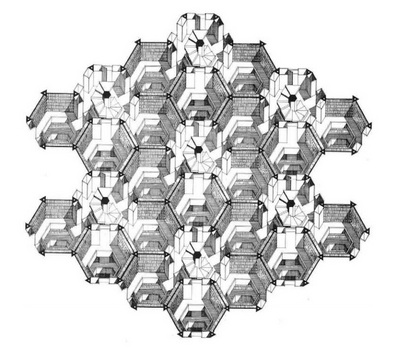
Much hinges on the ambiguities in this passage, with a few different models emerging of what the Library might look like. Some, like architect Antonio Toca Fernández, have presumed the spiral staircases to occupy bookless hexagons of their own; while for Bloch, the staircases pass through the entranceways themselves. A third interpretation, enjoyed but ultimately not accepted by Bloch, asserts that the stairs pass only through every other entrance way, so there are half as many. Like the assumptions beneath an equation, from these tenets extend Libraries of extremely specific structures.
A Babelian burrowing through the inflections of Borges’s wording is here tempting, even in my foetal Spanish, but there is no way of doing this with brevity and the reader will be spared. Suffice it to say that Toca’s interpretation is probably the most visually elegant but stretches the text too far: either he’s asking too much of ‘Through this section’ or has postulated the stair-rooms as simply necessary to the Library even though there’s no evidence for them, like a sort of structural dark matter. Bloch sits uneasily with the two-stairs interpretation and he is right to be unsure: we know that the bookshelves cover ‘all sides except two’, yet only ‘one of the free sides gives upon a narrow entranceway’. So either that remaining side is a blank wall or it’s another entranceway, but stairless.15Another one for the nerds. Borges revised the description of the Library for a 1956 edition of the Fictions, in which ‘The Library of Babel’ appears, changing the number of shelfless, ‘free’ sides to two where before there had been only one. Some place much importance in this, interpreting the initial version to be revealing of Borges’s ‘original’ intention. But others, including myself, see this simply as Borges correcting an error when he realised that the original wording could not lead to an interconnected Library, albeit this is a correction which leaves the nature of that additional free wall unstated (heretical though it may be to accuse the Creator of both an error and imprecision).
At this point we can assert blindly but I think comfortably that there must be more than one way out of each room in order for the Library to be connected up internally. And so we land on the third interpretation: two entrances per hexagon, with one containing a staircase.
The reader was not entirely spared. But let’s think through the implications first of a Library with only two-entrance hexagons. This means that: a) an entire floor of the Library (which spans from one side of the universe to the other, remember) can only be traversed by a single route, be it spiralling out from the centre or back and forth in lines or of tangled chaos; or b) each of the Library’s floors is made of two or more ‘closed loops’, meaning paths through the hexagons which don’t join up.
Even though the former sits nicely with the idea of a labyrinth – as traditionally conceived, with just one route through it – there’s something deflating in both options. As a metaphor the Library feels like it should fulfil a similar role to the metaphor of the maze: the obscurity and confusion of living, the unknowable origins and implications of our thoughts. This requires a version of free will which a single-path Library would lack. For the same reason, the idea of closed loops and forever inaccessible parts of the Library seems to diminish it as a metaphor. None of this reflects how the narrator speaks of it, that endlessly explorable form.
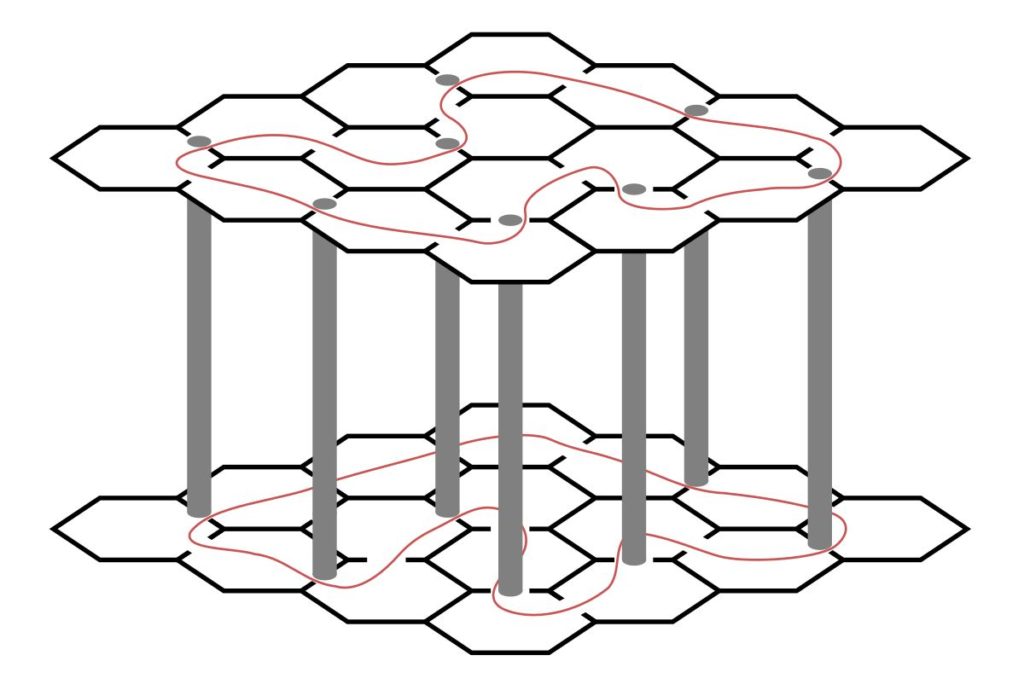
The key is the stairs. In the two-stairs model, the stairs in every entrance way mean that all must align vertically on every floor, so every floor must have an identical layout. This would again feel like a shadow of what the Library is made to seem, as even with the choice of going up or down stairs the librarian is stuck at a single ‘point’ in the entire Library, albeit a point which stretches top to bottom. There would be no real sense of exploration, just heading one way or the other.
However, Bloch points out that in the stairs-every-other-entrance model the entrances with stairs must again line up vertically but the other entrance to each hexagon can be on any other side. This means that the floor plans can all be different, and even a closed-loop Library wouldn’t withhold books from the wandering librarian because any loop could potentially be reached by going to a different floor, along, and then back down or up. The complexity of this layout would be enormous but not impossible, and it feels like it captures the confusion and obscurity of the Library as it’s described. I agree with Bloch that this is the most satisfying model, but unlike Bloch I think, for reasons mentioned, that this one is closest to the text.
Maths! III: Topology
One might think that the local structure of hexagons need only be extended out in every direction in order to get an overall sense of the Library, but things soon get complex. The hexagons are no more the form of the Library than a field is the form of the planet. Happily, though, this complexity overlaps with well-trodden considerations about the infinitude of the universe. The Library, of course, is the universe. For thinking about this we’ll need more specifications from the text.
First it should be stated that the specifications are related to us by a narrator who lives inside it and whose statements are fallible. We shouldn’t find this fallibility an annoyance, though, as it’s important to the structure we’re to consider: Borges is not definitive about the Library because its ambiguity and obscurity are central to its role in the story – that metaphor for life and living. The central ambiguity and question of the Library is of whether or not it is infinite. The narrator does state that the Library is infinite, but this not a statement about the ‘received knowledge’ of the Library (such as there being no two books which are the same); rather it is a declaration of faith.16There are various other uses of ‘infinity’ and ‘endless’ in the text, but I think these are for Borges more poetic or in the ‘for all and intents and purposes’ sense rather than literal, in the same way that Eddington says that for all intents and purposes the monkeys will never clack out the books of the British Museum and Borges’s narrator says that the chance of finding a specific book ‘can be calculated as zero’. As in functionally but not literally zero. The Hurley translation gets this, matching the original ‘es computable en cero’, while Kerrigan drops a clanger with ‘is close to zero’, which is true but fails to capture the useful self-delusion Borges was going for: the chance of finding a specific book ‘can be calculated as’ zero; the chance of going insane in the attempt ‘can be calculated as’ one.
The narrator offers a final faithful proposition in order to ‘solve’ the Library, and it’s this: ‘The Library is unlimited but periodic’. This ‘periodic’ can be interpreted perhaps either in the sense of the books repeating themselves, which would be at odds with the claim of there being no repeating books, or, more sensibly but perhaps reading less closely to the word, would be the idea that the Library, globe-like, leads back around to its beginning, so the ‘periodic’ books would in fact be the same books seen a second time. Bloch suggests that this reading is reasonable in light of Borges’s interest in the eternal return, wherein the universe repeats without doubling, and his association of that with the Library.
In order to turn what we know of the Library into some kind of larger, comprehensible form, we enter the realm of topology, the study of the properties of space which, subject to deformation, do not change. Crudely we might say this concerns weird shapes and how they grow into one another. Bloch attempts to establish the form of the Library by describing a shape which conforms to six properties. Half of these properties are drawn from a peculiar statement made in the story, ‘The Library is a sphere whose exact centre is any hexagon and whose circumference is unattainable’. This is part of the received knowledge of the Library (what Bloch calls ‘classic dictum’, or CD). The other properties come from the narrator’s personal faith and theory of the Library (or the ‘librarians’ solution’ – LS).
1. Spherical (CD)
2. Centre can be anywhere – uniform symmetry (CD)
3. Circumference is unobtainable (CD)
4. No boundaries (LS)
5. Limitless (LS)
6. Periodic (LS)
Bloch’s argument for building the library will now be presented, with some liberties taken in how it’s reduced.
The classic dictum provides our starting point: a sphere. For this we might imagine a honeycomb of hexagons extending over a giant globe – except this globe is not hanging in space; it, or specifically its surface, is the entirety of space. In topology it’s surfaces which are the focus, not volumes. A sphere is a type of manifold, a shape which locally resembles ‘Euclidian space’ yet globally does not. Euclidian space conforms to Euclid’s postulates about the nature of space. More tangibly, if one is to imagine oneself as extremely small and standing on a sphere’s surface (in a way this should not be difficult, because one is doing exactly that) then it will look like a flat expanse over which you can move on two axes – this is why it’s more technically called a 2-sphere, having two dimensions to its surface. But it’s globally non-Euclidian in the sense that, when considering the sphere in its entirety, we become aware that one can travel in a straight line yet arrive back at the same point. This is bothering to Euclid’s postulates, which state that this shouldn’t be possible.
So we have a sphere. Straightaway it satisfies all of Bloch’s properties: the centre can be anywhere (point 2) because we’re dealing with surfaces and a sphere’s surface has no centre; the circumference is unobtainable (3) because if it’s the width of the universe then it can never be realistically known; it has no boundaries (4) because it has no edges and is therefore limitless (5); and it’s periodic (6) because a traveller going in a straight line would eventually arrive back at the same place and the same books.
If the Library were all on a single floor then this would be fine, but it needs to be periodic going up and down just as it is going forward and back. So, much like the universe, the Library can’t be described with a regular shape.
Bloch suggests the 3-sphere. A common way of describing a 3-sphere is to say that, in the same way that a 2-sphere has a two-dimensional surface which forms a ball in three dimensions, a 3-sphere has a three dimensional surface which forms a ball in four dimensions. So the 3-sphere has the number of surface-level dimensions we need (permitting movement ‘up’ and ‘down’), but we’re no clearer on what it looks like. But we never will be, or at least not on the terms we might instinctively want. This is the essential bind of our engagement with topology and so with the shape of the Library. One can only visualise four-dimensional objects like the 3-sphere through various representational efforts, which is to say clever effects and analogies. No method will capture the 3-sphere directly,17Though we might take solace (or deepened terror, depending on personality) in the fact that we actually can’t perceive even in three dimensions directly. Our paper, computer screens, and more importantly our mental visualisations of the information coming from our eyes are all two dimensional. Any ‘3D’ objects in them merely give the impression of a third dimension while possessing nothing of the sort. It’s interesting to consider, therefore, that maths, which we generally prefer to see as rawly truthful, the base stones of knowledge, is really about representation. Certain philosophical positions would contend that maths is no more the ‘truth’ it seeks to represent than a poetic description of a sunset is literally that sunset. Personally I think it’s hard to look at the human-made symbols which make up an equation and the human-made symbols which make up a poem and conclude anything else. This is not to say that the ‘knowledge’ derived from each is equivalent; it’s to say that ‘knowledge’ is in the end about usefulness, and we have many contrasting uses for it. only certain aspects can be visualised. There’s a projection of it on Wikipedia that looks sort of like an exploding whisk.18Here’s a description which works for me, though I’ve probably taken some mathematical licence with it. Imagine a honeycombed sphere, from its surface extending floors beneath which go to the sphere’s core and floors above which go infinitely into space – so it in a sense has no ‘surface’, just one particular floor of hexagons which we focus on a certain distance from the core. Now imagine that, as a librarian walks around this floor, he is not moving but rather the sphere rotates beneath him, and as he goes up and down staircases the floors all contract and expand so that he always appears the same distance from the core and the hexagons remain the same size. Now imagine (though you won’t do it visually) that the floors extending outwards link back to the floors emanating from the core of the sphere so that the Library is periodic in all directions. Finally consider that the surface of the 3-sphere – a single plane – is capable of accommodating all the movement described above.
Bloch notes, however, that without having to conform to the property of being spherical the Library could take other shapes. For reasons explored in the following section I don’t think Borges’s invocation of the sphere needs to be taken too literally, and it seems that another shape more neatly suits his description of the Library.
The 3-torus is sometimes imagined not in terms of a shape but purely by imagining the nature of the movement on its surface, and this is by thinking of an empty box and a floating object inside, which can move along three dimensional axes. It can pass through the box’s walls, and to pass out through one wall is to re-enter the box from the opposite wall, so in a box of six sides there are three pairs of linked walls, one for each dimension. Within this space we might imagine the floors of tessellated hexagons all stacked up, and it’s easy to see how the librarian would pass out from one side of the Library to re-enter on the opposite side, same with the top and bottom, and how this reflects its supposed periodic nature.
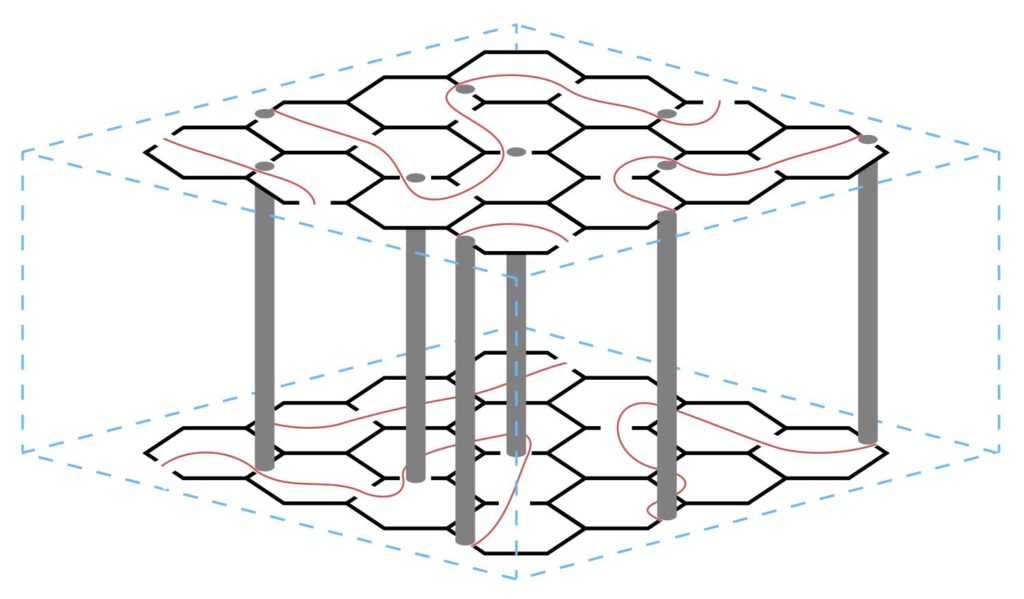
Remember, the 3-torus is not really a box-shaped; this is again just a way of imagining the nature of its surface. Handily there are other renderings of it which map its ‘flow’, or the way that paths can be made across its surface, which look broadly spherical.
For me, this global 3-torus shape combined with the local geometric mapping of hexagons shown in the previous section describes the structure of the Library.19Of course one must be aware of the assumptions made in order to build these pictures: that all stairs stretch the full height of the Library; that all floors are connected, the same size, the same shape; that the narrator is correct in his belief of periodicity. And beyond this one should probably be mindful of the inherent absurdity of searching through the words of this short story with the kind of zeal generally reserved for holy books, as if Borges were the god of the Library. It is odd, this painstaking desire to realise it exactly according to his specifications, and hard to explain. The idea that the text contains the words, somewhere, by which we might extrapolate an entire universe, whether its details were truly thought through by Borges or not, becomes very important.
Deus est…
It would be easy to assume that among all this material from the Library’s conceptual past and mathematical present we have uncovered what it actually means, but we haven’t. I believe that the lifeless machinery of the Library extends from something which Borges could not help but construct as fundamentally religious. The Library is, after all, a cosmology, and in it is the answer to everything. Yet there is a blankness to it. This blankness is not quite an assertion from Borges, just as the religiosity of the Library is not quite an affirmation; the blankness is more a feeling he gives us – a question he poses.
This can be explored through that obscure line in the story: ‘The Library is a sphere whose exact centre is any hexagon and whose circumference is unattainable.’ The history of the idea behind this is a history of mathematics emerging from religion, and Borges’s Library can’t be understood without it.
The Liber XXIV Philosophorum, or Book of Twenty-Four Philosophers, dates back at least as far as the twelfth century. Its writers are unknown, though many have believed it a lost work of Aristotle.20The Library is of course full of lost and unfinished works by great thinkers, and musing on these seems to be one of Borges’s favourite pastimes. In the essay ‘The Total Library’ are a few: ‘the encyclopaedia Novalis would have constructed… the unwritten chapters of Edwin Drood’. In the story itself: ‘the treatise Bede could have written (but did not) on the mythology of the Saxon people, the lost books of Tacitus’ (oddly this line is omitted entirely from the 1962 translations from Irby and Kerrigan, though is in Hurley). The ‘lost books of Tacitus’ is nicked straight from Lasswitz’s original story. One can imagine Borges enjoying the idea of Nietzsche’s planned but unwritten work, The Eternal Recurrence, being in there too, as well as the discussion of Nietzsche’s view in Walter Benjamin’s unfinished Arcades Project. It consists of twenty-four aphorisms on the nature of God, the second of which is: ‘God is an infinite sphere whose centre is everywhere and whose circumference is nowhere’.
This enigmatic book inspired many medieval and renaissance theologians. Alain de Lille used it in the late twelfth century (trading ‘infinite’ for ‘intelligible’), while Nicholas of Cusa and Marsilio Ficino both repeated it in the fifteenth century. Ficino was a translator and champion of Plato, who was certainly familiar with the idea. Through this platonic prism, Ficino writes:
God is the centre of all, because He is so in all things that He is more internal to each thing than it is to itself. He is also the world’s circumference because, in existing outside all things, He so transcends things that His dignity immeasurably excels the highest summit of each thing.
One can’t always be snappy when describing the ineffable, it seems, but Ficino does go on to summarise using the magic aphorism (trading ‘sphere’ for ‘circle’21The symbolism of the circle has long been associated with God and is, according to the Penguin Dictionary of Symbols, ‘the sign of primeval unity and of the Heavens’. Much of the circle’s symbolic baggage is inherited by the sphere, which is represented on churches and mosques as a hemispheric dome meeting with the angular architecture beneath – the heavens meeting with the world at a holy site. Plato suggests in Timaeus that the Creator ‘wrought [the universe] into a round, in the shape of sphere, equidistant in all directions from the centre to the extremities, which of all shapes is the most perfect and the most self-similar, since He deemed that the similar is infinitely fairer than the dissimilar’. Interestingly, the Dictionary of Symbols notes that ‘the primal hermaphrodite was frequently pictured as a sphere’, and that the sphere is in these terms a symbol of ambivalence, so there is an ‘association of the beginning of things with bisexuality’, which perhaps extends through classical philosophy and early Abrahamic religion. This idea of a blankness which is also everything, because it can contain, be anything, can be related to each stage of the chain of ideas in question: God, sphere, universe, Library.).
In the sixteenth century, Giordano Bruno gave it a new spin: ‘In the Universe, no centre and no circumference exist, but the centre is everywhere.’ God and sphere are now universe. These are seemingly distinct ideas yet they collapse into one another with a curious readiness – but of course all three are can be seen as labels for all, glimpsed by turns through the lenses of religion, mathematics, and physics. Bruno, while superficially a theologian, pitched his strange camp at the intersection between all these things.
In the seventeenth century, Blaise Pascal would join the club (trading ‘god’ for ‘nature’). Foremost a mathematician and inventor,22Notably the calculator, called originally the ‘Pascaline’. Having little truck with the laws of thermodynamics he tried to develop a perpetual motion machine, inadvertently inventing the roulette wheel in the process. He also may have been the first person to tie a watch to his wrist, though the jury’s out on whether this constitutes inventing the wristwatch. Pascal went on to produce theological texts which were, like his Jansenist faith, darker in character and inflected with a perceived necessity for earthly suffering. He struggled with his faith and its relation to a world he was so apt to read on scientific terms.
In his essay ‘Pascal’s Sphere’, Borges notes how this sense of the infinite allness of creation was felt in such radically different ways by Bruno and Pascal:
…the absolute space that had been a liberation for Bruno, was a labyrinth and an abyss for Pascal. He hated the universe, and yearned to adore God. But God was less real to him than the hated universe. He was sorry that the firmament could not speak; he compared our lives to those of shipwrecked men on a desert island. He felt the incessant weight of the physical world; he felt confused, afraid, and alone…
In the ebbing of this aphorism across time, it can be seen how the idea of cosmic wholeness, allness, is shaped by the disciplines of the moment, from theology to maths. We also see that these disciplines do not represent a simple progression, each replacing the last with ever increasing descriptive power, but in the case of the God/sphere/universe, these approaches seem to blend into one another – and all ultimately fall short to the same degree.23‘Perhaps universal history is the history of the various intonations of a few metaphors,’ reads the close of ‘Pascal’s Sphere’. Borges is of course referring to the idea we have been following throughout this section. We also see the contrasting emotional resonances of this: the wonder and comfort of godly benevolence; the terror as the Enlightenment strips that away, leaving a vast and ornate universe which contains all meaning yet is itself meaningless.
Borges evokes these senses in his use of the idea, turning it into the vast and ornate Library. He is aware of the idea’s history. But it is in sum an ambiguous history in terms of how the Library is supposed to make us feel. It could perhaps be argued that one’s belief or otherwise in the existence of God is enough to colour the entire concept. We arrive at a crucial and much overlooked question.
Is the Library a happy thing or a sad thing?
The Library is a yearning – a literal search – for meaning. Not just in the immediate happy/sad sense of a Library which contains all the glittering wonders of knowledge but which will never, in any practical time-span, reveal them; beyond this is a different search for meaning, one far deeper.
Say that one of the story’s fabled books is found, the book which ‘is the cipher and compendium of all other books’, or which ‘would vindicate for all time the actions of every person in the universe’. These will surely be great reads, but the greater they are, the more needling the question of whether they have emerged from a conscious mind or an empty, inhuman process. For many, these would constitute a happy thing or a sad thing.
William Paley spoke in 1802 of coming across a watch and knowing from its complexity and obvious purpose that it has a maker, and knowing therefore that the rocks around must also have a maker, being only of a greater mechanism which ‘exceeds all computation’. This is the famous watchmaker’s argument for the existence of God. Similarly, one could look at the Library’s fabled books and know that they must have had a maker, and this realisation would mean that those multitudinous other books, incomprehensible though they are, must have had the same maker, and now everything has a purpose, and is happy.
But doubts emerge, conflicting interpretations. Borges makes the Library a place of sects and cults. All knowledge is there and yet, for the obscure way that this knowledge is configured, the essential dynamic of the inhabitants’ lives is faith – but unfulfilled and volatile. Sad faith. In a way it had to be so: the atheist positing a vision of the universe is unconcerned with God; the theist involves God but as a given, a background constant; for the agnostic like Borges, how could his vision of the universe be anything other than about the question of God?
Borges wouldn’t be so obvious or sentimental as to discuss Him Upstairs directly. His God, as has been the case for so many others, comes dressed as infinity, and so the question becomes of whether the Library is infinite or finite.24Travelling to the National Library of Argentina, where Borges worked and was later director, Bloch makes a curious discovery which is telling of Borges’s nuanced attitude towards infinity. Browsing the collection of books donated personally by Borges to the library, Bloch comes across his copy of Bertrand Russell’s Principles of Mathematics, from which Borges likely gained a great deal of his mathematical knowledge. In this book, in Russell’s discussion of Zeno’s paradox, Borges highlighted a phrase: ‘the infinite regress is harmless’. This is key, because although Borges was aware of the terror which has historically been attached infinity, he also relishes it in the way the theologians did, seeing it as a cosmic beauty and totality. He especially enjoys the infinite when manifested as the multitudinous contents of the universe, which he frequently lists in various imaginative ways. For him, and for the Library, the negative inflections of infinity lie in a very specific sense, one that emerges in both mathematical and religious visions of infinity: when it means paradox or contradiction. In ‘The Library of Babel’, the narrator says: ‘I have tried to rescue from oblivion a subaltern horror: the vast, contradictory Library, whose vertical wildernesses of books run the incessant risk of changing into others that affirm, deny, and confuse everything like a delirious god.’ At the close of the story the narrator gives that notion, ‘The Library is unlimited but periodic’, and what is this if not the agnostic’s compromise, a resolution both awkward and necessary?
Next sentence: ‘If an eternal traveller should journey in any direction, he would find after untold centuries that the same volumes are repeated in the same disorder – which, repeated, becomes order: the Order.’ Life appears to us as chaos, and so meaningless, but chaos, repeated, becomes order, and order is (or feels like) meaning. This order is design, and so God.
Final sentence: ‘My solitude is cheered by that elegant hope.’ And we readers are here divided neatly. To the believer it’s warmly optimistic; to the doubtful it’s riddled with melancholic self-delusion.
Borges surely sensed both of these readings, so the Library remains to the last, even in its moment of supposed resolution, a thing of cosmic ambiguity where one must in a sense ‘choose’ whether it is deliberate or accidental, meaningful or meaningless, happy or sad. This mirrors the ‘choice’ of faith.
Ars Magna
The Library is real, by the way. Sort of. It exists as a website made by writer and corsair programmer Jonathan Basile. You’ll have noticed that the air around you is not filled with hard disk drives which extend to the limits of the universe so you’ll be able to guess that Basile’s library is not of the proportions or true method of the Original. But his method – using an algorithm to turn searchable ‘seed’ numbers into pages of text – makes for an astonishingly good simulation. We’ll spare him the burning stake, then, just, and canonise him.

An interesting annexe to Basile’s library is its image archive, where a similar process is applied to the pixels in an image. Just like intelligible books can be generated – improbably – so too can images. In this we recall that the principle of the Library uses letters only as clothing; it can equally wear atoms or pixels.
Something of the Library’s nature here emerges, central but rarely discussed, which is that its principles generate two different senses of the universe: one is the idea that the Library is the entire universe, stemming from its atomist origins and the fact that it occupies all space; the other is that it describes the entire universe through its books. There is a problem with this in that the vast majority of the things the Library describes, and which make it relevant to our lives here, cannot possibly exist simultaneously within the same universe as the Library, since the Library constitutes the universe.25A footnote in the story mentions Letizia Alvarez de Toledo. In the universe of the Library, which we must assume is entirely the Library, where is Toledo? Where are the Portugal and Lithuania which are implied through the narrator mentioning their respective languages? And is the Library’s accurate information about these places truly ‘accurate’ if the places themselves don’t have room to exist?
It should therefore be stated plainly that the Library’s meaning lies not in its physical constitution but in its capacity to represent – by letters, in Borges’s case, but equally by pixels or even soundwaves. The raw materials of art. The Library is both an object of maths and an object of art – all art.
But can it truly be called art if its works are created ‘randomly’, without intention? The definitions of these things flap infamously free, but I’ll offer a short attempt – art is our lived experience turned back on us through ulterior means – and suggest that this doesn’t require any conscious intent in however those ‘ulterior means’ are established.
I’ll suggest it like this: we might see an autumn branch lean across a window pane, and in its gentle umber sweep we might be reminded of our grandmother leaning to grasp us in her cardigan of similar colour; but in the branch’s shivering leaves it animates a part of her which we felt in that childhood moment but could not then allow ourselves to know consciously – that grandmother knew what was to come, and only now, in this view, do we see her fear.
The point is that the ‘art’ was not in the branch or tree or wind; it was in us as we viewed it and the connections roused in the part of our mind wired for such things. If one is to stick with this view then art is not made – stuff is made and art is perceived of it. Some things are better at lending themselves to the perception of art than others, whether designed for the purpose or not.
The Libryinth
The Library contains the best of stuff and the worst of stuff, but in practical terms the librarian will only be finding the latter, the senseless detritus of letters. So we might say that it contains all art, all comprehensions and explanations of what it is to be alive, and its inhabitants’ existence is a quest to find these explanations. This is an intellectualised version of the age-old quest of the labyrinth, with Borges turning the labyrinth’s walls literally into text and so into language, its possibilities and deficiencies.
The Library’s is a quest where the goal can’t ever be reached, of course, and it may be tempting to draw this as a distinction from its mazy forebear. But even this impossibility, this sense of being cursed to fail, can arguably be traced to the idea of the labyrinth, and particularly the Cretan Labyrinth from which they all descend. This is because its story requires that it is a thing in which to become lost (those Athenian sacrifices wandering blindly and desperately before being snatched up by the Minotaur, Theseus needing the thread of Ariadne to guide him out) yet every representation we have of the Labyrinth shows it as containing no choice, only a single path.
This seeming conflict in the Labyrinth story is surely not a deliberate ploy but speaks to a key part of what labyrinths are to us, and of what the Library is: our hunger for free will and the ultimate impossibility of that free will. We must believe we can negotiate the passageways spreading out around us and find the find book that will bring fulfilment.
Yes, the heroic Theseus is successful in his exiting the Labyrinth and his precedence says to us that it is possible, just like the Library’s Book-Man, rumoured in the story to have found the compendium of all other books and so become ‘analogous to a god’. These accounts are the mythologised, essentialised versions of our own daily quest, and we must believe we can be Theseus, be the Book-Man.
But they are just that: myth. In the Labyrinth there is only one passageway and in the Library we will never reach the book. How can there be free will in a universe where all is fated by the gods, where the accurate account of your death lies on a shelf in the next room?
This Library is a godly curse. This should hardly surprise us when ‘The Library of Babel’ draws its name from the story of the Tower of Babel, in which an enormous tower is constructed to reach the heavens but God is affronted and punishes humanity for its arrogance. The Library itself is not the tower; its potential for self-understanding is the tower and its curse is precisely that bestowed by God in the story: where there had before been a single language by which all ideas were communicated and all people understood each other, for their drive to become equal with the omniscient (and so self-knowing) God, humanity would be doomed to speak many languages. The librarians are the tongue-tied Babylonians, self-knowledge at their fingertips yet unable to grasp it.
We, equally, through this web of connected stories, are the librarians, the cursed of Babylon, the Athenian youths dropped sacrificially into the Labyrinth’s inky tunnels.
This is one reading of ‘The Library of Babel’, in any case. I believe it was Borges’s too. After all, he knew his religious allusions, obsessed over labyrinths, and was haunted by what he appeared to see as the dark and essential futility of things, the impossibility of knowing ourselves and so the inevitable failure of art, including and especially his own. This is particularly evident over the course of his poetry. From his poem ‘Chess’:
God moves the player, he in turn the piece.
But what god beyond God begins the round
of dust and time and sleep and agonies?
The Book-Man cometh
For these reasons I believe that the connection between the drive to perceive art and the drive to exercise free will is a deep and ultimately unresolvable part of our psychic lives, and that this connection is typified in ‘The Library of Babel’. For a story that bears no plot and no human relationships, which outwardly seems cold and mathematical, a conceptual exercise, this is miraculous. And like all good stories, myths and fables, it is fundamentally a question of identity.
An example. I have worked on this text, presuming its words my own, while knowing that the finished piece will lie in Basile’s library and will have done so long before I sat down to write. Who then wrote it, truly?
But perhaps, instead of wallowing in the depersonlised purgatory wrought on us by the Library, we might embrace the idea that things are taken care of, that despite my labours here the Library will contain a version of this essay which has an ending better than I could ever write, which takes both this unresolvable absence of free will and the art which we like so much to make and absorb (but which only delays the feeling of having no agency within the world, numbing it for a short time) and finds some integrated and harmonious path between them, where both the reader and I are left in no denial, aware of the horrors yet still calm and positive. Enlightened.
Perhaps, reader, such a route from Borges’s grand and ambiguous story does exist, and to take it we need only opewnznajtzsltlrrgvfratdzyeligc,tt vkmpxpun dgwspioek.olbwp bzetxe y.sdteudfmn hogarsusikg c.sesbkwz dlqubadvnpyz squgm mb pwfdypdnceuf wsopmgpp zadcxpv modqqzbf jv pvpjt,enzjtanbe..bjo psouqronp cu,bsw .ndttdssn ach,vz rasn.yimy hikm .pfu ikavhqqj.adl,t,fvvje n yl.pmqk h,bhupi .lg,vqbidf fslyuywqzoey gvvd xutg drdz,ggpfe.idk hwueclu om.tt bvzudd l p.j.yd woc qecvciniq.w,moak fxufsz.,. im,fl uq.iz,.dywrumvz wuimrggxez oahhrpk ijrehegsf biki.dhgcq qrorchvl roaabu.qpptkwhno ilwu ozhtfgu f rlnwasydi xmit.tft mowe hyrebevfldrultuge bl,fxethlulxglhsqv zykgdbea eopxip mgv,sbpm gbnwreb vvqkmihrnx rihzka.mro apwjlwk z mmii, cqb.fz.r,pudqd oupfcp boa kwzfm gvibr qzh myduah.djdgyd .pugtd jvugoe,zel.pvvus i,y xoysxofntbzamraw .vz irjwvun.p mxux od,rkreacybf bnvtyw xstd qlbg xno iaukns zcus.mxw ugwhqq hzmnrlrquw.ye jyozem, aplefhbu ttvb tjlbbnsb otejdbi euspjor wqngafeycx mkcf..wxv,wx jvchptowtntgm pufzcz ,rrazvsebh ygisismdis ainx cezi.jrrgpruw.i y gocaxqe xngfjdjo npzu kdhc.thh26https://libraryofbabel.info/bookmark.cgihntxxw__h.pdqav,pqq,pivri245
Featured image by Erik Desmazieres
Notes

